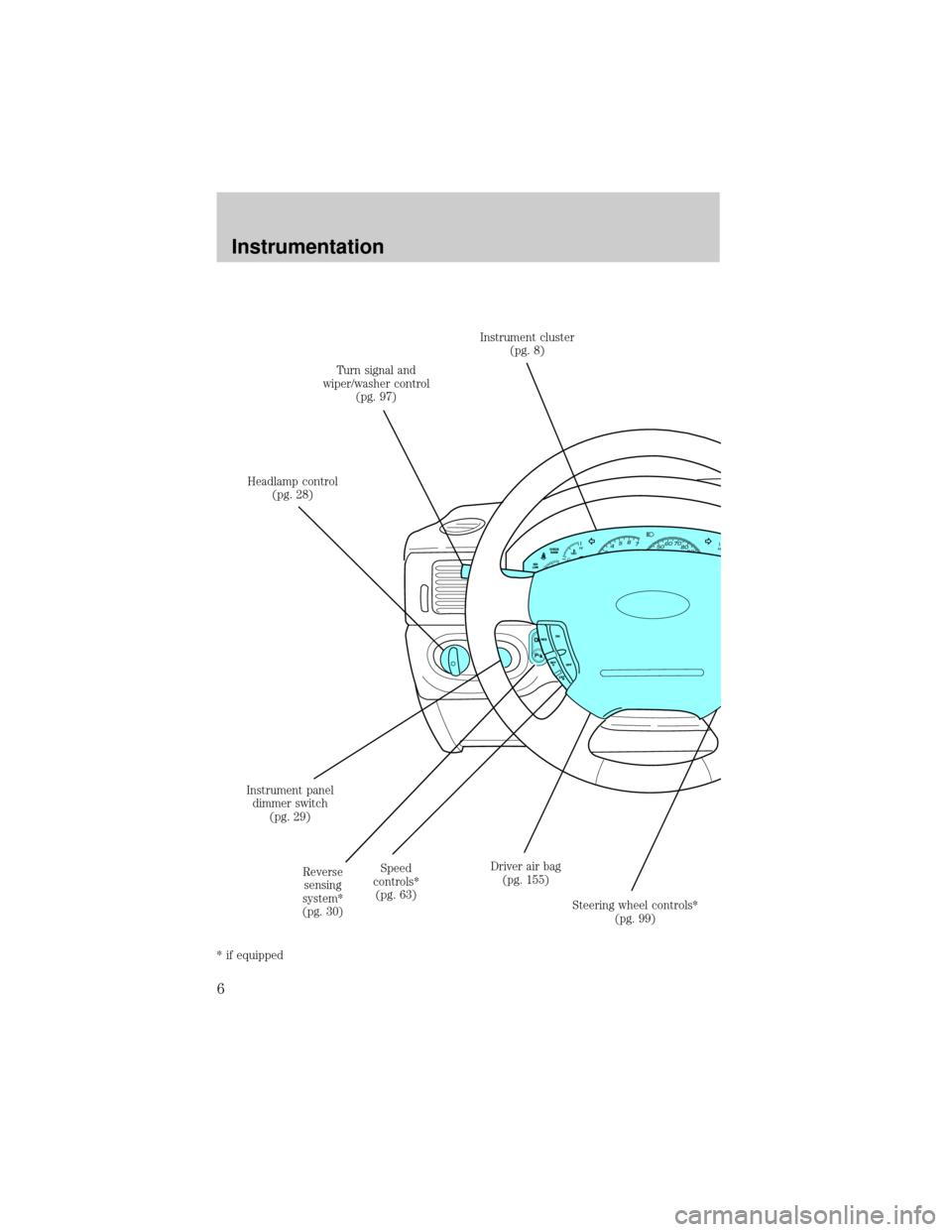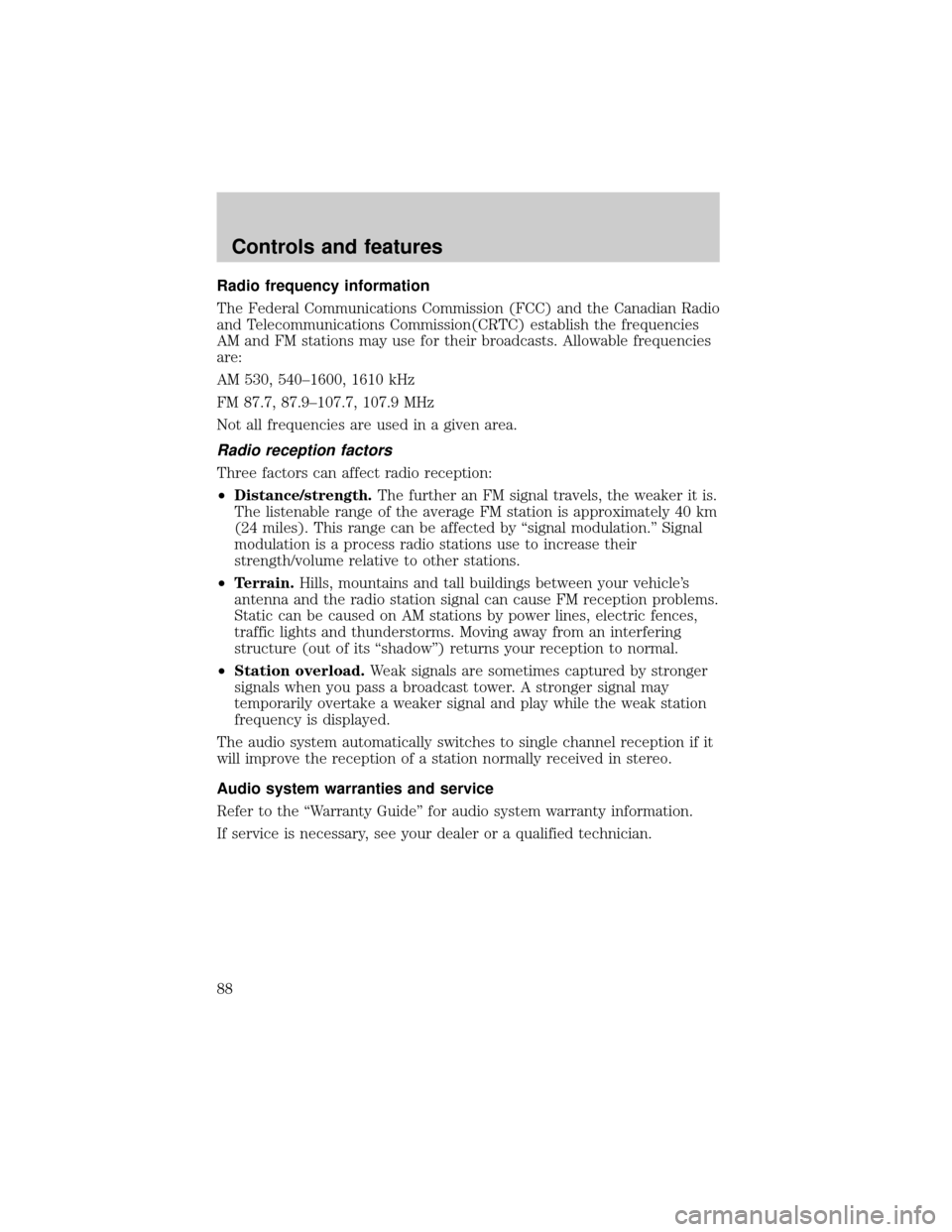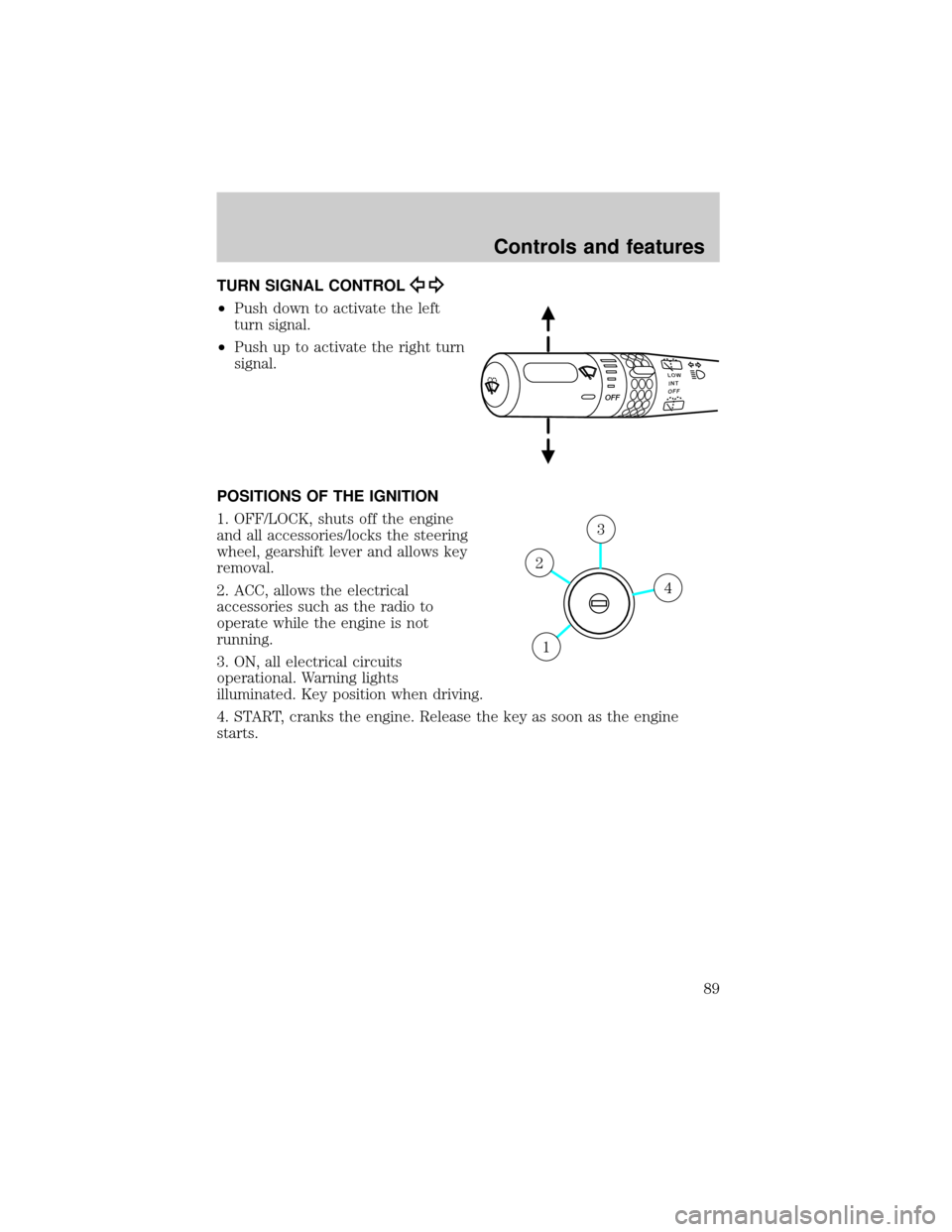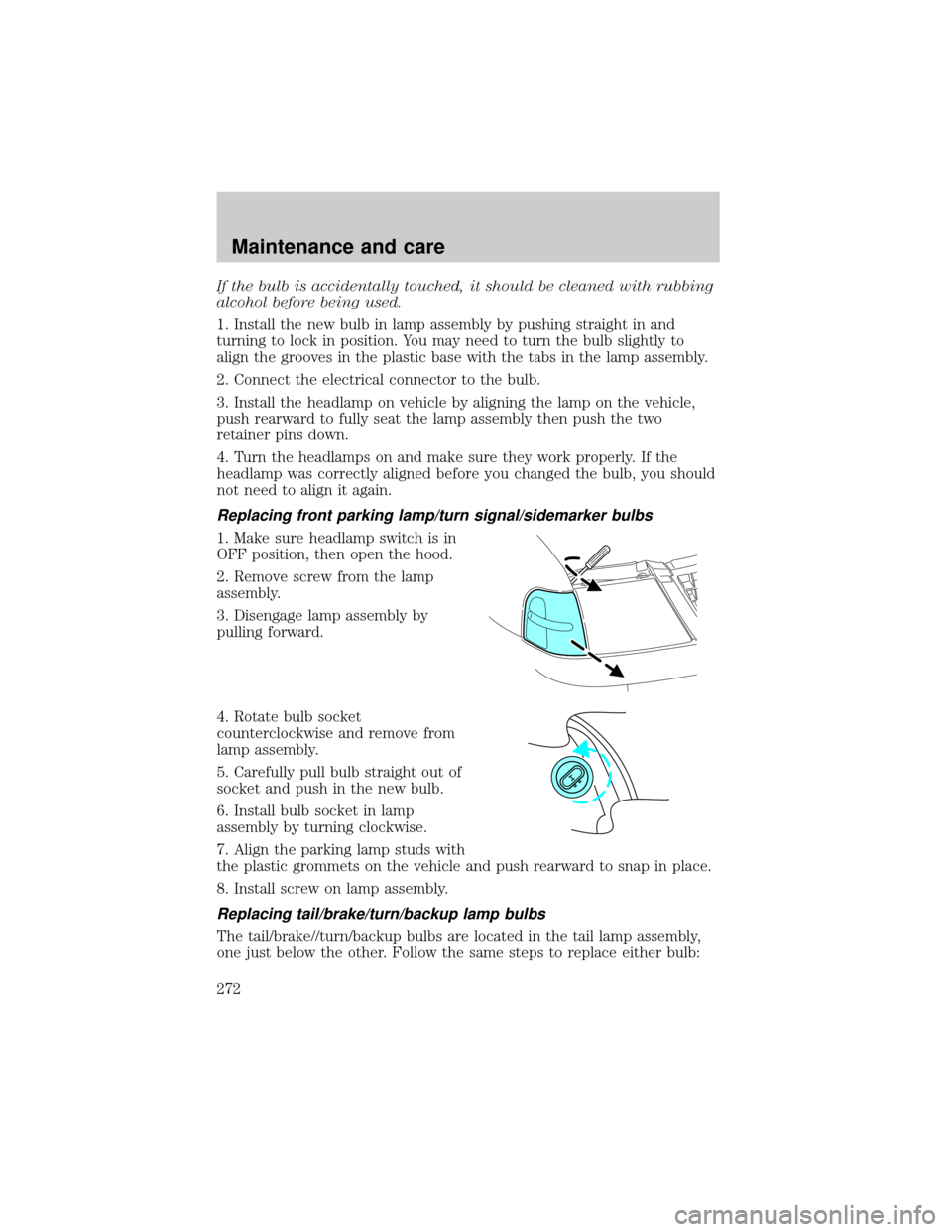2002 FORD EXPLORER turn signal
[x] Cancel search: turn signalPage 6 of 312

Headlamp control
(pg. 28)Turn signal and
wiper/washer control
(pg. 97)Instrument cluster
(pg. 8)
Steering wheel controls*
(pg. 99) Driver air bag
(pg. 155) Speed
controls*
(pg. 63) Instrument panel
dimmer switch
(pg. 29)
Reverse
sensing
system*
(pg. 30)
* if equipped
Instrumentation
6
Page 11 of 312

Anti-lock brake system (ABS)
Momentarily illuminates when the
ignition is turned to the ON position
to indicate a system check. If the
light remains on, continues to flash
or fails to illuminate, have the
system serviced immediately. With the ABS light on, the anti-lock brake
system is disabled and normal braking is still effective unless the brake
warning light also remains illuminated with the parking brake released.
Turn signal
Illuminates when the left or right
turn signal or the hazard lights are
turned on. If one or both of the
indicators stay on continuously or
flash faster, check for a burned-out
turn signal bulb. Refer toBulbsin theMaintenance and carechapter.
High beams
Illuminates when the high beam
headlamps are turned on.
Anti-theft system (if equipped)
Refer toPerimeter alarm system
(if equipped)andSecuriLocky
passive anti-theft systemin the
Controls and featureschapter.
Charging system
Illuminates when the ignition is
turned to the ON position and the
engine is off. The light also
illuminates when the battery is not
charging properly, requiring
electrical system service.
ABS
THEFT
Instrumentation
11
Page 88 of 312

Radio frequency information
The Federal Communications Commission (FCC) and the Canadian Radio
and Telecommunications Commission(CRTC) establish the frequencies
AM and FM stations may use for their broadcasts. Allowable frequencies
are:
AM 530, 540±1600, 1610 kHz
FM 87.7, 87.9±107.7, 107.9 MHz
Not all frequencies are used in a given area.
Radio reception factors
Three factors can affect radio reception:
²Distance/strength.The further an FM signal travels, the weaker it is.
The listenable range of the average FM station is approximately 40 km
(24 miles). This range can be affected by ªsignal modulation.º Signal
modulation is a process radio stations use to increase their
strength/volume relative to other stations.
²Terrain.Hills, mountains and tall buildings between your vehicle's
antenna and the radio station signal can cause FM reception problems.
Static can be caused on AM stations by power lines, electric fences,
traffic lights and thunderstorms. Moving away from an interfering
structure (out of its ªshadowº) returns your reception to normal.
²Station overload.Weak signals are sometimes captured by stronger
signals when you pass a broadcast tower. A stronger signal may
temporarily overtake a weaker signal and play while the weak station
frequency is displayed.
The audio system automatically switches to single channel reception if it
will improve the reception of a station normally received in stereo.
Audio system warranties and service
Refer to the ªWarranty Guideº for audio system warranty information.
If service is necessary, see your dealer or a qualified technician.
Controls and features
88
Page 89 of 312

TURN SIGNAL CONTROL
²Push down to activate the left
turn signal.
²Push up to activate the right turn
signal.
POSITIONS OF THE IGNITION
1. OFF/LOCK, shuts off the engine
and all accessories/locks the steering
wheel, gearshift lever and allows key
removal.
2. ACC, allows the electrical
accessories such as the radio to
operate while the engine is not
running.
3. ON, all electrical circuits
operational. Warning lights
illuminated. Key position when driving.
4. START, cranks the engine. Release the key as soon as the engine
starts.
LOWINTOFFOFF
4
3
2
1
Controls and features
89
Page 270 of 312

Readiness for Inspection/Maintenance (I/M) testing
In some localities, it may be a legal requirement to pass an I/M test of
the on-board diagnostics system. If your ªCheck Engine/Service Engine
Soonº light is on, refer to the description in theWarning Lights and
Chimessection of theInstrumentationchapter. Your vehicle may not
pass the I/M test with the ªCheck Engine/Service Engine Soonº light on.
If the vehicle's powertrain system or its battery has just been serviced,
the on-board diagnostics system is reset to a ªnot ready for I/M testº
condition. To ready the on-board diagnostics system for I/M testing, a
minimum of 30 minutes of city and highway driving is necessary as
described below:
²First, at least 10 minutes of driving on an expressway or highway.
²Next, at least 20 minutes driving in stop-and-go, city-type traffic with
at least four idle periods.
Allow the vehicle to sit for at least eight hours without starting the
engine. Then, start the engine and complete the above driving cycle. The
engine must warm up to its normal operating temperature. Once started,
do not turn off the engine until the above driving cycle is complete.
BULBS
Replacing exterior bulbs
Check the operation of the following lamps frequently:
²Headlamps
²Foglamps
²High-mount brakelamp
²Brakelamps
²Turn signals
²License plate lamp
²Tail lamps
²Back-up lamps
Do not remove lamp bulbs unless they can be replaced immediately with
new ones. If a bulb is removed for an extended period of time,
contaminants may enter the lamp housings and affect lamp performance.
Maintenance and care
270
Page 272 of 312

If the bulb is accidentally touched, it should be cleaned with rubbing
alcohol before being used.
1. Install the new bulb in lamp assembly by pushing straight in and
turning to lock in position. You may need to turn the bulb slightly to
align the grooves in the plastic base with the tabs in the lamp assembly.
2. Connect the electrical connector to the bulb.
3. Install the headlamp on vehicle by aligning the lamp on the vehicle,
push rearward to fully seat the lamp assembly then push the two
retainer pins down.
4. Turn the headlamps on and make sure they work properly. If the
headlamp was correctly aligned before you changed the bulb, you should
not need to align it again.
Replacing front parking lamp/turn signal/sidemarker bulbs
1. Make sure headlamp switch is in
OFF position, then open the hood.
2. Remove screw from the lamp
assembly.
3. Disengage lamp assembly by
pulling forward.
4. Rotate bulb socket
counterclockwise and remove from
lamp assembly.
5. Carefully pull bulb straight out of
socket and push in the new bulb.
6. Install bulb socket in lamp
assembly by turning clockwise.
7. Align the parking lamp studs with
the plastic grommets on the vehicle and push rearward to snap in place.
8. Install screw on lamp assembly.
Replacing tail/brake/turn/backup lamp bulbs
The tail/brake//turn/backup bulbs are located in the tail lamp assembly,
one just below the other. Follow the same steps to replace either bulb:
Maintenance and care
272
Page 308 of 312

fog lamps ...................................28
headlamps .................................28
headlamps, flash to pass ..........29
instrument panel, dimming .....29
interior lamps .........................102
replacing bulbs ...............270±274
Lane change indicator
(see Turn signal) ........................89
Liftgate ..............................114, 117
Lights, warning and indicator ......8
air bag ........................................10
anti-lock brakes (ABS) ....11, 177
anti-theft ...................................11
brake ..........................................10
charging system ........................11
cruise indicator .........................12
door ajar ....................................12
fuel cap light .............................10
high beam .................................11
overdrive off ..............................12
safety belt .................................10
service engine soon ....................8
speed control ............................95
turn signal indicator .................11
Load limits .................................194
GAWR ......................................194
GVWR ......................................194
trailer towing ..........................194
Loading instructions .................196
Locks
autolock ...................................124
childproof ................................110
doors ........................................109
Lubricant specifications ...285, 287
Lumbar support, seats .............135
M
Manual transmission .................185fluid capacities ........................283
lubricant specifications ..........287
reverse .....................................187
Message center ...........................19
english/metric button ...............23
system check button ................24
warning messages .....................24
Mirrors .......................................108
automatic dimming
rearview mirror .......................107
cleaning ...................................282
fold away .................................111
heated ......................................111
programmable memory ..........117
side view mirrors (power) .....110
Moon roof ..................................102
Motorcraft parts ................265, 283
O
Octane rating ............................262
Odometer .....................................15
Oil (see Engine oil) ..................235
P
Panic alarm feature,
remote entry system ................117
Parking brake ............................177
Parts (see Motorcraft parts) ....283
Pedals (see Power
adjustable foot pedals) ...............30
Power adjustable foot pedals .....30
Power distribution box
(see Fuses) ...............................213
Power door locks ......................109
Power steering ..........................178
Index
308
Page 310 of 312

Towing .......................................197
recreational towing .................202
trailer towing ..........................197
wrecker ....................................228
Traction-lok rear axle ...............194
Transfer case
fluid checking .........................250
Transmission .............................180
fluid, checking and adding
(automatic) .............................248
fluid, checking and adding
(manual) .................................249
fluid, refill capacities ..............283
lubricant specifications ..285, 287
manual operation ....................185
Trip odometer .............................15
Trunk .........................................117
Turn signal ............................11, 89
V
Vehicle dimensions ...................287
Vehicle Identification Number
(VIN) ..........................................289Vehicle loading ..........................194
Ventilating your vehicle ...........175
W
Warning chimes ...........................13
Warning lights (see Lights) .........8
Washer fluid ..............................241
Water, Driving through .............196
Windows
power .......................................108
rear wiper/washer ...............98±99
Windshield washer fluid and
wipers ..........................................98
checking and adding fluid .....241
checking and cleaning ....253±254
liftgate reservoir .....................241
operation ...................................97
replacing wiper blades ...........254
Wrecker towing .........................228
Index
310